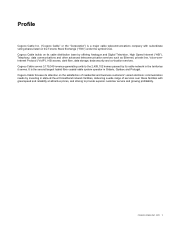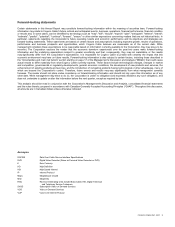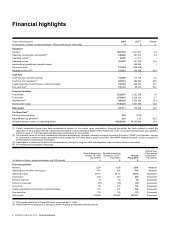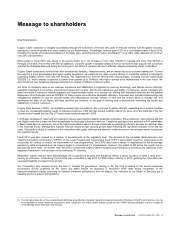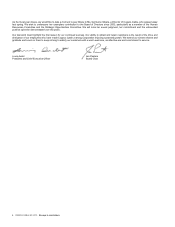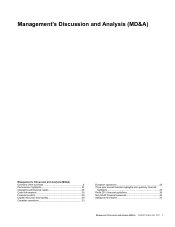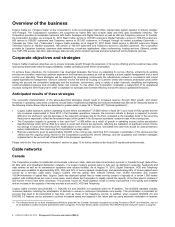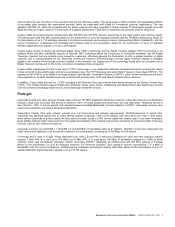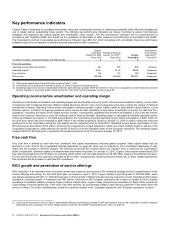Cogeco 2010 Annual Report Download - page 12
Download and view the complete annual report
Please find page 12 of the 2010 Cogeco annual report below. You can navigate through the pages in the report by either clicking on the pages listed below, or by using the keyword search tool below to find specific information within the annual report.Management’s Discussion and Analysis (MD&A) COGECO CABLE INC. 2010 11
Critical accounting policies and estimates
The preparation of consolidated financial statements in accordance with Canadian GAAP requires management to adopt accounting policies
and to make estimates and assumptions that affect the reported amounts of assets and liabilities, contingent assets and liabilities and revenue
and expenses during the reporting year. A summary of the Corporation’s significant accounting policies is presented in note 1 on page 49 of the
consolidated financial statements. The following accounting policies were identified as critical to Cogeco Cable’s business operations.
Revenue recognition
The Corporation considers revenue to be earned as services are rendered, provided that collection is reasonably assured. The Corporation
earns revenue from several sources. The recognition of revenue from the principal sources is as follows:
• Revenue from Cable Television, HSI, Telephony and other telecommunication services are recognized when services are rendered;
• Revenue generated from sales of home terminal devices is recorded as equipment revenue upon activation of services as management
considers the sale of home terminal devices as a single unit of accounting of a multiple element arrangement;
• Installation revenue is deferred and amortized over the average life of a customer’s subscription for residential customers, not exceeding
four years, and over the term of the contract for business customers. Management considers that installation revenue is part of a multiple
element arrangement and has no standalone value. Accordingly, installation revenue is deferred and amortized at the same pace as
revenue from Cable Television, HSI, Telephony and other telecommunications services are earned;
• Promotional offers are accounted for as deductions from revenue when customers take advantage of such offers.
Amounts received or invoiced that do not comply with these criteria are accounted for as deferred and prepaid revenue.
Allowance for doubtful accounts
The majority of the Corporation’s revenue is earned from residential and business customers. Accordingly, allowance for doubtful accounts is
calculated based on the specific credit risk of its customers by examining such factors as the number of overdue days of the customer’s
balance owing as well as the customer’s collection history with Cogeco Cable. As a result, conditions causing fluctuations in the aging of
customer accounts will directly impact the reported amount of bad debt expense.
Accrued liabilities
The preparation of financial statements requires management to make estimates and assumptions that affect the reported amounts of accrued
liabilities at the date of the financial statements and the reported amounts expensed during the year. Actual results could differ from those
estimates.
Capitalization of direct labour and overhead
Capitalization of costs includes the expenditures to acquire, construct, develop or improve an item of property, plant or equipment, as well as all
costs directly attributable to those activities. The cost of an item includes direct construction or software development costs, such as materials,
labour and overhead costs directly attributable to the construction or software development activity. The cost to enhance the service potential of
an item is considered an improvement and as a result is capitalized. Costs incurred in the maintenance of service potential are expensed.
Cogeco Cable capitalizes direct labour and direct overhead costs incurred to construct new assets, enhance existing assets and connect new
customers. Although capitalization of financial expense is permitted for construction activities, it is the Corporation’s policy not to capitalize
financial expense for construction activities.
Amortization policies and useful lives
Cogeco Cable amortizes fixed assets and intangible assets with finite useful lives over their estimated useful lives. In estimating useful lives,
the Corporation considers such factors as life expectancy of the assets, changing technologies and cable and telecommunications industry
trends. The Corporation reviews its estimated useful lives on a regular basis. If changes in the above-mentioned factors happen more quickly
than anticipated, Cogeco Cable may have to shorten the estimated lives of certain assets, which could result in a higher amortization expense
in future periods.
Capitalization of costs to acquire customers
The Corporation incurs significant costs to reconnect or activate additional services for Basic Cable, HSI, Digital Television and Telephony
customers. These costs include material and labour costs incurred to reconnect or activate additional services for customers. Reconnect and
additional service activation costs are capitalized up to a maximum amount not exceeding the revenue generated by the reconnect activity.
These costs are amortized over the average life of a customer’s subscription, not exceeding four years. The average life of a customer’s
subscription is reviewed annually and changes could have a significant impact on the amortization expense.


